Here, a general spatial fire brigade unit network density optimization problem will be solved. The optimal distance between fire brigade units positions is denoted OFD. In the analysis, the distance is denoted by x and the optimal distance, OFD, is denoted by x* in order to make the exposition easier to follow.
The optimization problem
In equation (1), we maximize the expected total value per area unit.
(1)
N(x) is the Net value of the region under consideration, per square kilometer, as a function of x, the distance between fire stations, in kilometers. The cost per fire station is cx (USD/Day). N0 denotes the value of the area in case wild fires never occur and the number of fire stations would be zero. The probability that a wild fire occurs within a particular square kilometer, a particular day, is p. The travel time for a fire engine, from the fire to the closest fire station, is y. C is the cost of a fire and E(C) is the expected value of C. In this analysis, we do not consider cases where a particular fire brigade unit simultaneously is engaged in several fires. In multiple fire events, we rely on assistance from neighbor fire stations and water bombing airplanes. In equation (2), L(x) is defined as the expected total cost of fire stations and fires.
(2)
We may express the maximization problem as in equation (3).
(3)
We may understand L(x) as the difference between N0 and N(x). Compare (4).
(4)
Now, we will focus on the minimization of L(x), as in (5).
(5)
We let stars indicate optimal values.
(6)
We simplify the notation this way:
(7)
The first order optimum condition is:
(8)
In case we can show that the second order minimum condition (9) is satisfied, then we have a unique minimum (10). However, this will be investigated in detail before we can be sure.
(9)
(10)
If we have a unique optimal solution, then the optimal solution may hopefully be obtained from the first order optimum condition:
(11)
The expected cost as a function of x
We consider a road network with parallel two-way roads, from West to East (WE) (and the opposite direction, EW) and from South to North (SN) (and the opposite direction, NS). (Of course, the model is still relevant even if the directions are quite different, as long as the different directions are perpendicular to each other.) The total area of the road network is very large. In order to simplify the exposition and the derivations, we consider it to be infinite. Hence, we do not have to consider special cases along the boundaries of the total network. Fire stations are located with constant distances between them, along the West to East roads (WE) and along the South to North roads (SN). If we consider four neighbor fire stations, they are found in the different corners of a square, defined by roads that together form a perfect square. The distances between the closest stations are x. The distances between parallel roads are constant and much shorter than x. To simplify the analysis, we use the approximation that these distances are zero. The distance from an arbitrary point to the closest station, in direction WE or EW is less than or equal to x/2. The distance from an arbitrary point to the closest station in direction SN or NS is also less than or equal to x/2. If a fire starts in a point Q, then the fire brigade that has the shortest total distance to Q travels to Q. The fire brigade has to follow the roads in the network. The probability that a wildfire starts is the same everywhere, which means that the probability density is constant. Hence, a spatially uniform wild fire probability density function is applied. The expected travel distance from the closest station to Q, in the EW or WE direction, is x/4, and the expected travel distance in the SN or NS direction, is x/4. Hence, the expected total travel distance from the closest station to Q is x/2. We assume that the travel time is proportional to the travel distance. This is approximately correct if vehicle acceleration and retardation time intervals only represent very small parts of the total travel time.
T is the time it takes to go between two neighbor fire brigade unit locations. x (km) is the distance and s (km/min) is the speed. Note that the speed, s, depends on the properties of the fire engines and the roads. It would be possible to extend the analysis by also optimizing the fire engine speed and the road quality. The unit of T is minutes.
(12)
We assume that the travel time in direction WE or EW is y1 and the travel time in direction SN or NS is y2. The uniform probability density function of the travel time from the closest fire brigade unit to the fire, in the WE or WE direction can be expressed as:
(13)
Furthermore, the uniform probability density function of the travel time from the closest fire brigade unit to the fire, in the SN or NS direction, y2, can be expressed as:
(14)
The total travel time, y, is y1 + y2. The probability density function of y is f(y). This can be determined via convolution based on the probability density functions of and y1 and y2, namely f1(y1) and f2(y2). Now, via convolution, we can determine the probability density function of the total travel time y, via the following function:
(15)
Inspection reveals that the probability density function of the total travel time can be explicitly described as:
(16)
Hence, the probability density is a “triangular” function of total travel time. It is important to determine the optimal distance between fire stations under different conditions. In other words, we want to optimize x as a function of relevant parameters. We are interested to minimize the expected value of the expected total cost of the complete system. In this process, it is necessary to calculate the expected cost of the fire(s) as a function of x. The expected cost of a fire can be determined via two functions, namely the cost as a function of total travel time and the probability density function of total travel time. This is found here:
(17)
Using the derived probability density function of total travel time, we get the following expression for the expected cost:
(18)
The fire cost function is approximated as an exponential function of total travel time. Of course, the analysis in this paper can also be adjusted to other functional forms of fire cost functions, if locally relevant empirical data motivate that.
(19)
With the selected fire cost function, we get the following expression for the expected fire cost:
20)
(21)
Integration section
In order to calculate the expressions, we need the following integral in several places:
(22)
From the Leibniz product rule, we know that:
(23)
We may integrate the left hand and the right hand sides of the equality.
(24)
(25)
(26)
(27)
Then, we get:
(28)
(29)
This may be expressed as:
(30)
Then we have the solution:
(31)
Test:
(32)
Explicit solution
In equation (33), we utilize the solution (31).
(33)
This is developed to (34).
(34)
Then, we get equation (35).
(35)
After some elimination, we obtain equation (36), which is then simplified to (37).
(36)
(37)
We may also express the expected cost as a function of x and s, which is found in (38).
(38)
The new variable introduced in equation (39) represents a way to simplify the following expressions. This way, we get (40).
(39)
(40)
In order to solve the optimization problem, we need the first order derivative found in (41).
(41)
Since we are interested in the sign of (41), we simplify the analysis further. We introduce a new function (43), also found in (42).
(42)
(43)
(44)
(45)
(46)
As we see in (47), the sign of the function is strictly positive.
(47)
Thanks to the observation (47), we can determine the sign of the derivative (48).
(48)
In (49), (50) and (51), more results follow.
(49)
(50)
(51)
Now we know that the expected fire cost is a strictly increasing function of the total travel time between neighbor fire stations, the two exponents in the fire cost function and the distance between fire stations. The expected fire cost is a strictly decreasing function of the speed of the fire engines.
Investigation of the second order derivative
We want to make sure that a solution to the first order optimum condition (8) really is a minimum. If possible, we also want to know if a solution is a global minimum. This investigation is made in several steps, with new partial functions, as illustrated in equations (53) to (68).
(52)
(53)
(54)
(55)
(56)
(57)
(58)
(59)
(60)
(61)
(62)
(63)
(64)
(65)
(66)
(67)
(68)
Now, we know that the expected fire cost really is a strictly convex function of the distance between fire stations.
Comparative statics analysis
Now, we want to know how the optimal decisions are affected by possible parameter changes. We start with the first order optimum condition (69).
(69)
We differentiate the first order optimum condition with respect to the optimal value of x and the probability p.
(70)
(71)
(72)
(73)
(74)
(75)
(76)
(77)
Hence, as expected, we see that the optimal distance x is a strictly decreasing function of the probability p. It is obviously more important to have shorter distances to go to reach the fires if the probability of fires increases.
With the corresponding procedure, it can also be proved that:
(78)
We may now summarize the general results: If the probability that a fire starts, p, increases, then the optimal distance between fire stations decreases. The optimal distance also decreases in case the fire cost function, C(y), increases, via one or two of the parameters a and b. The optimal distance between fire stations increases if the cost per fire station increases. If the speed of fire engines increases, because of improved fire engines and/or because of better roads, then the optimal distance between fire stations increases.
Numerical results
In the earlier section, it was proved that the optimal distance between fire brigade unit positions, x, which minimizes the total expected cost, is unique. x is a continuous variable and optimal solutions are usually not integers. The optimal solution can however not be expressed via an explicit function. Here, we will investigate the optimal integer solutions. The method enumeration in combination with the fact that the continuous objective function is proved to be strictly convex, makes sure that the optimal integer solutions are found. In this process, also the optimal expected total costs, are derived. With comparative statics analysis, it was proved that x is a strictly decreasing function of the expected number of fires per area unit, a strictly increasing function of the speed of the fire engines, a strictly decreasing function of the parameters of the exponential fire cost function, and a strictly increasing function of the cost per fire station. These effects of parameter changes are also illustrated via graphs in this numerical section. Compare the Figures 1 – 8.
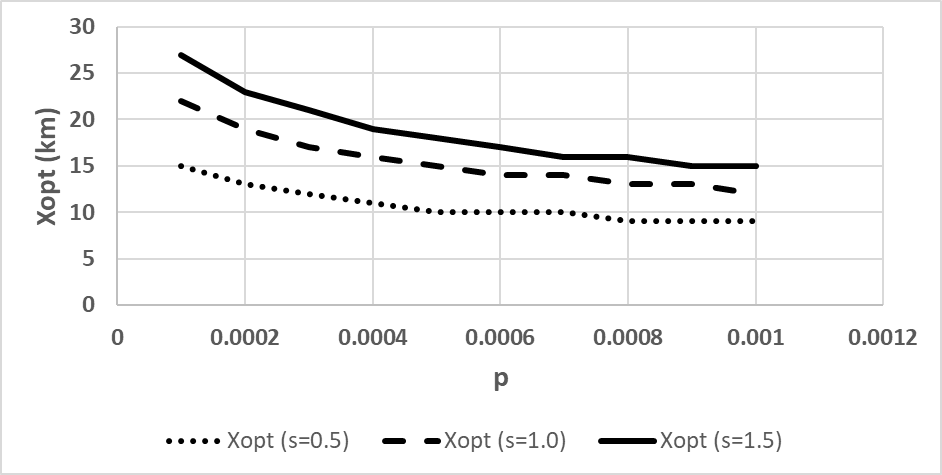
Figure 1 The optimal fire station distance, Xopt=x*, (km), as a function of p, the fire probability per square km and day, and s, the average speed of a fire engine (km/min). Default assumptions: a=10000 (USD), b=0.1, cx=1000 (USD/Day).
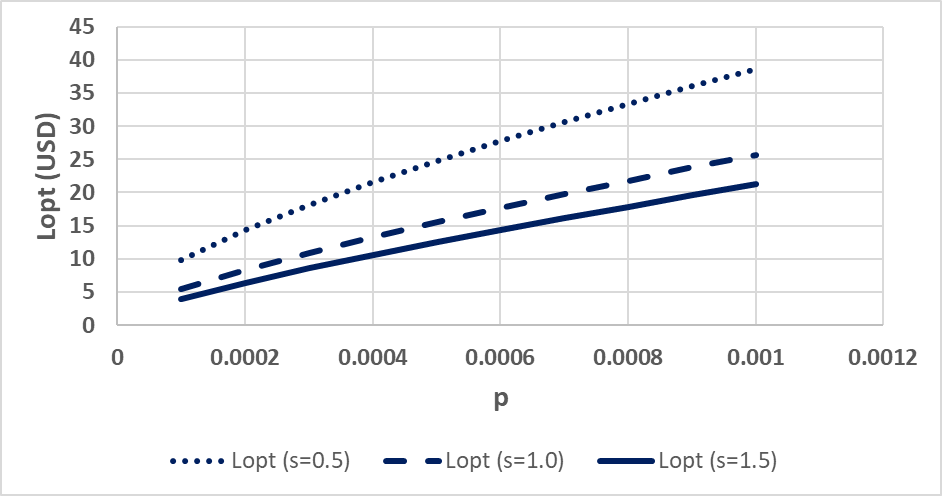
Figure 2 The minimal expected total cost function value, Lopt = L*, (USD), per day and square km, as a function of p, the fire probability per square km and day, and s, the average speed of a fire engine (km/min). Default assumptions: a=10000 (USD), b=0.1, cx=1000 (USD/Day).
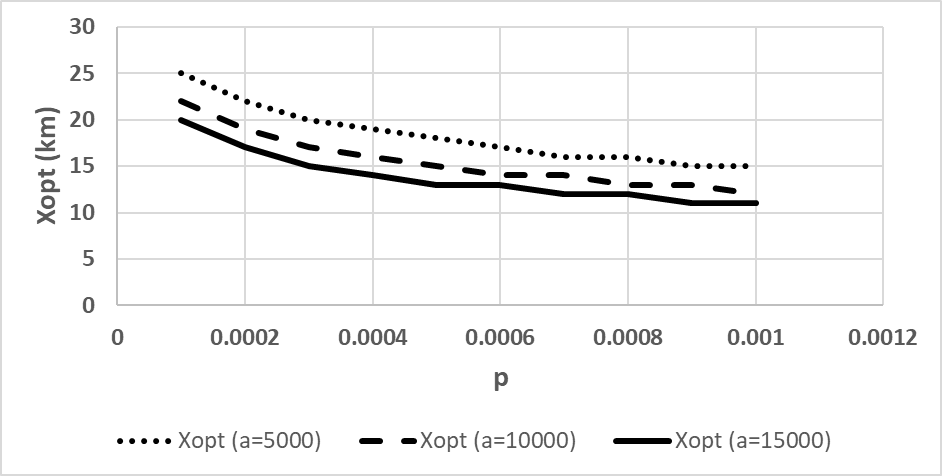
Figure 3 The optimal fire station distance, Xopt=x*(km), as a function of p, the fire probability per square km and day, and a, the expected cost per fire in case the travel time of the fire engines would be zero. Default assumptions: b=0.1, s=1 (km/min), cx=1000 (USD/Day).
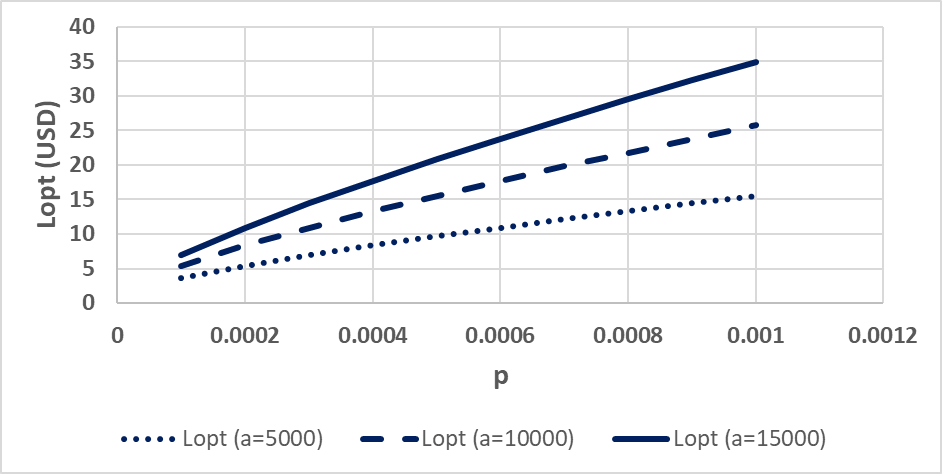
Figure 4 The minimal expected total cost function value, Lopt = L*, (USD), per day and square km, as a function of p, the fire probability per square km and day, and a, the expected cost per fire in case the travel time of the fire engines would be zero. Default assumptions: b=0.1, s=1 (km/min), cx=1000 (USD/Day).
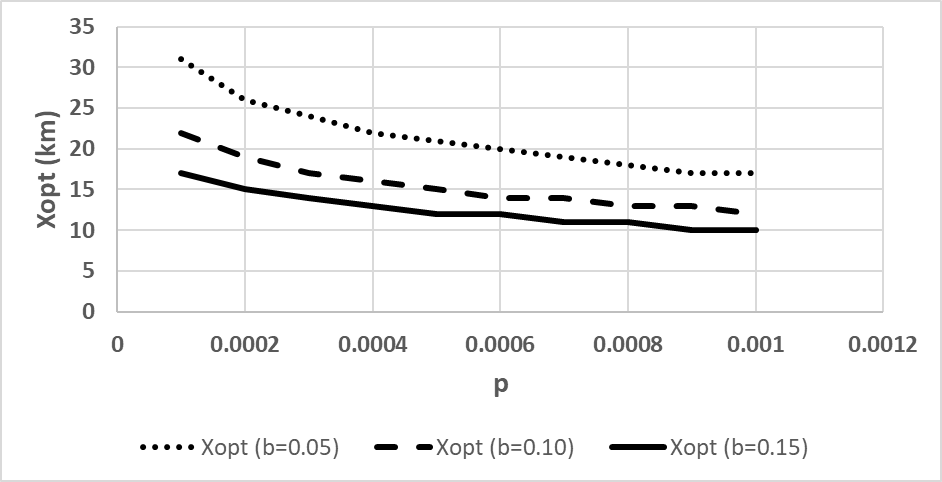
Figure 5 The optimal fire station distance, Xopt=x*, (km), as a function of p, the fire probability per square km and day, and b, the coefficient of exponential growth in the cost function. Default assumptions: a=10000 (USD), s=1 (km/min), cx=1000 (USD/Day).
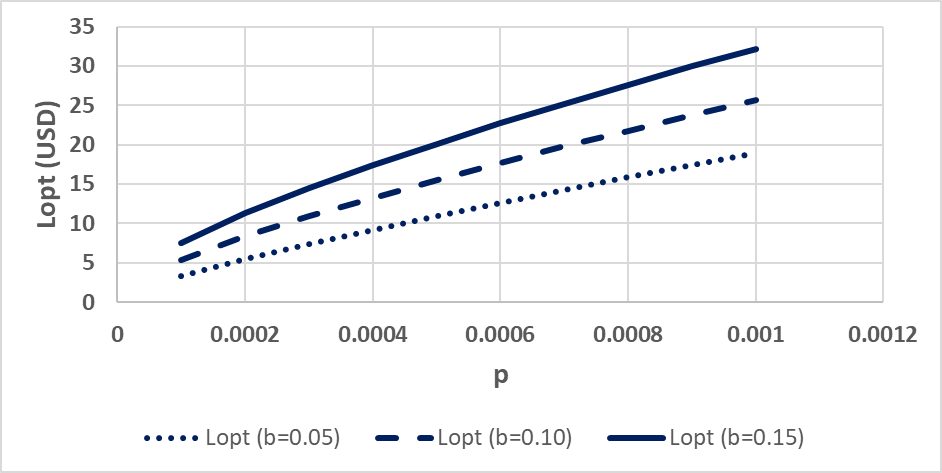
Figure 6 The minimal expected total cost function value, Lopt = L*, (USD), per day and square km, as a function of p, the fire probability per square km and day, and b, the coefficient of exponential growth in the cost function. Default assumptions: a=10000 (USD), s=1 (km/min), cx=1000 (USD/Day).
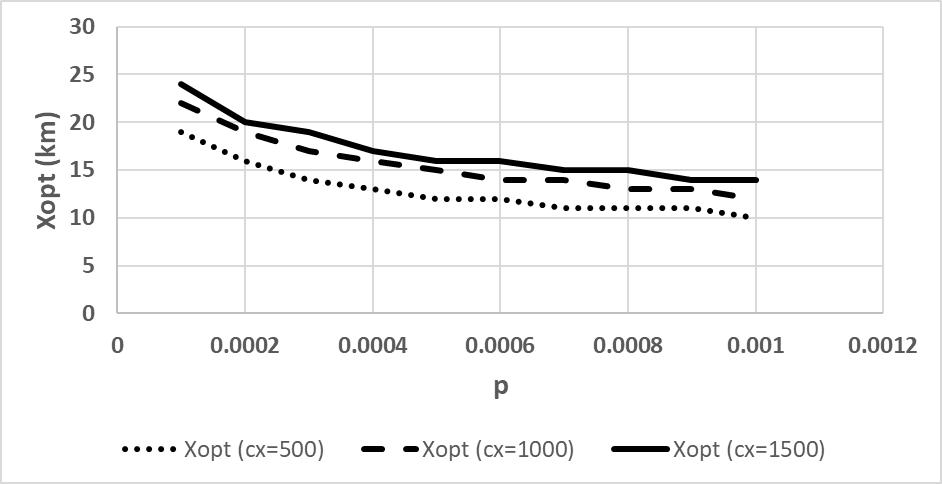
Figure 7 The optimal fire station distance, Xopt=x*, (km), as a function of p, the fire probability per square km and day, and cx, the cost per fire station (USD/day). Default assumptions: a=10000 (USD), b=0.1, s=1 (km/min).
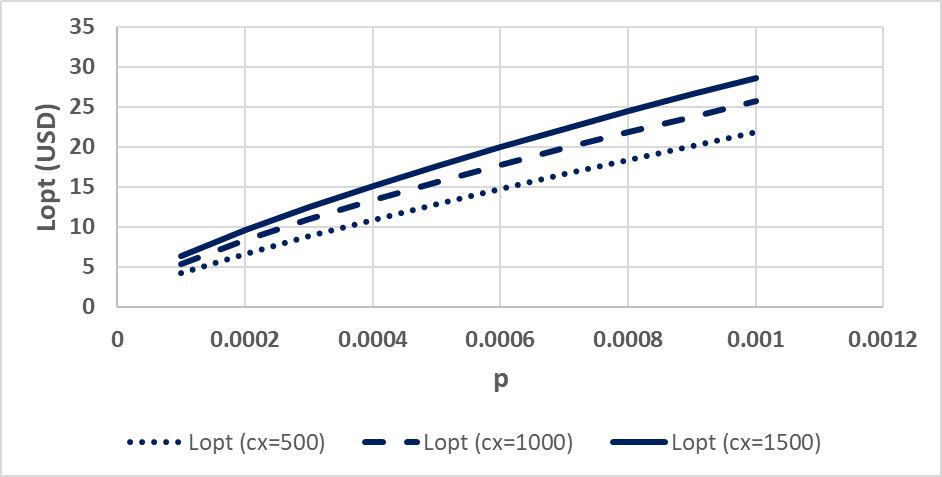
Figure 8 The minimal expected total cost function value, Lopt = L*, (USD), per day and square km, as a function of p, the fire probability per square km and day, and cx, the cost per fire station (USD/day). Default assumptions: a=10000 (USD), b=0.1, s=1 (km/min).








